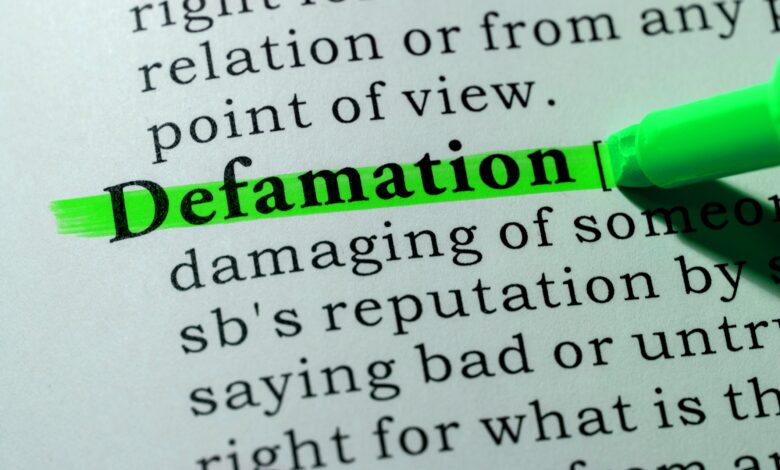Online Defamation and Legal Remedies in Australia
This article explores the nuances of online defamation, the legal framework governing defamation and legal remedies in Australia,.

In the digital age, where information spreads rapidly across platforms like social media, blogs, and forums, online defamation has become a pressing concern for individuals and businesses in Australia. Defamation and Legal Remedies are critical topics for anyone navigating the complexities of reputational harm in the online space. Defamation occurs when false statements damage a person’s reputation, and with the internet’s global reach, the impact can be swift and far-reaching. Understanding Defamation and Legal Remedies in Australia is essential for protecting your rights and seeking justice when your reputation is unfairly tarnished.
This article explores the nuances of online defamation, the legal framework governing Defamation and Legal Remedies in Australia, and practical steps to address reputational harm. With over 2500 words, we’ll cover everything from defining defamation to exploring remedies like injunctions, damages, and apologies, ensuring you’re well-equipped to tackle this issue.
What is Defamation in Australia?
Defamation is a legal term referring to the publication of false statements that harm an individual’s or entity’s reputation. In Australia, defamation laws aim to balance the right to free speech with the need to protect reputations. Defamation and Legal Remedies are governed by the Defamation Act 2005 in most states and territories, which standardizes the legal approach across the country.
Types of Defamation
Defamation is divided into two categories:
- Slander: Spoken defamation, such as defamatory remarks made in a podcast or video.
- Libel: Written or published defamation, common in online contexts like social media posts, blogs, or news articles.
Online defamation typically falls under libel, as it involves written or visual content shared on digital platforms. For Defamation and Legal Remedies to apply, the defamatory material must meet three criteria:
- Publication: The statement must be communicated to at least one person other than the victim.
- Falsehood: The statement must be factually incorrect.
- Harm: The statement must cause or be likely to cause serious harm to the victim’s reputation.
For example, a false tweet accusing a business of fraudulent practices could qualify as defamation if it damages the business’s reputation and meets these criteria.
The Rise of Online Defamation
The internet has transformed how defamation occurs. Social media platforms like X, Facebook, and Instagram, along with review sites like Google Reviews and Yelp, provide fertile ground for defamatory statements. A single negative post or comment can go viral, causing significant reputational and financial damage. Defamation and Legal Remedies are increasingly relevant as online platforms amplify the speed and scale of harm.
Common Examples of Online Defamation
- False Reviews: A competitor posting fake negative reviews about a business.
- Social Media Attacks: Tweets or posts falsely accusing someone of misconduct.
- Blog Posts or Articles: Publishing misleading information about an individual or company.
- Forum Comments: Anonymous users spreading false rumors on platforms like Reddit.
The accessibility of online platforms means anyone can publish defamatory content, often anonymously, making Defamation and Legal Remedies a critical tool for victims seeking redress.
Legal Framework for Defamation in Australia
Australia’s defamation laws provide a robust framework for addressing Defamation and Legal Remedies. The Defamation Act 2005 applies uniformly across most jurisdictions, with slight variations in some territories. Below, we outline the key elements of this framework.
Elements of a Defamation Claim
To succeed in a defamation lawsuit, a plaintiff must prove:
- The Statement Was Defamatory: The material must lower the plaintiff’s reputation in the eyes of a reasonable person.
- Identification: The statement must identify the plaintiff, either directly or indirectly.
- Publication: The statement must be communicated to a third party.
- Serious Harm: Since reforms in 2021, plaintiffs must demonstrate that the defamatory statement caused or is likely to cause serious harm to their reputation.
Defences to Defamation
Defendants in defamation cases can rely on several defences, which can complicate Defamation and Legal Remedies. Common defences include:
- Truth: If the statement is substantially true, it is not defamatory.
- Honest Opinion: The statement was an opinion based on true facts and made in good faith.
- Public Interest: The statement was made in the public interest and the defendant acted responsibly.
- Triviality: The statement was unlikely to cause harm.
These defences highlight the importance of consulting a legal expert to assess the strength of a Defamation and Legal Remedies case.
Statutory Reforms in 2021
In 2021, Australia introduced significant reforms to defamation laws to address the challenges of online defamation. Key changes include:
- Serious Harm Threshold: Plaintiffs must prove serious harm to their reputation, reducing frivolous claims.
- Single Publication Rule: The limitation period for defamation claims starts when the material is first published, even if it remains online.
- Concerns Notice: Before filing a lawsuit, plaintiffs must issue a concerns notice to the publisher, giving them a chance to resolve the issue.
These reforms make Defamation and Legal Remedies more accessible while ensuring the legal process is fair and efficient.
Legal Remedies for Online Defamation
Victims of online defamation have several options for seeking Defamation and Legal Remedies in Australia. The appropriate remedy depends on the case’s circumstances, including the extent of harm and the defendant’s actions.
1. Concerns Notice
Under the Defamation Act 2005, a concerns notice is the first step in pursuing Defamation and Legal Remedies. This formal document notifies the publisher of the defamatory material and requests its removal or correction. The publisher has 28 days to respond with an offer to make amends, such as an apology or retraction. If resolved, this can avoid costly litigation.
2. Injunctions
An injunction is a court order requiring the defendant to remove defamatory material or refrain from publishing it further. Injunctions are a proactive Defamation and Legal Remedies option, preventing further harm. For example, a court may order a website to delete a false article or a social media user to remove a defamatory post.
3. Damages
Damages are the most common remedy in defamation cases. Courts may award:
- Compensatory Damages: To compensate for reputational harm, emotional distress, and financial losses.
- Aggravated Damages: If the defendant’s conduct was malicious or reckless.
- Exemplary Damages: To punish the defendant and deter similar behavior (rare in Australia).
The amount of damages varies based on the case’s severity. In 2019, actor Geoffrey Rush was awarded $2.9 million in a defamation case against a newspaper, highlighting the significant financial stakes in Defamation and Legal Remedies.
4. Apologies and Retractions
Courts may order the defendant to issue a public apology or retraction, which can help restore the plaintiff’s reputation. This remedy is often sought in conjunction with damages or injunctions as part of Defamation and Legal Remedies.
5. Right of Reply
In some cases, victims may negotiate a right of reply, allowing them to publish a response to the defamatory material. This can be an effective Defamation and Legal Remedies strategy for correcting misinformation without escalating to litigation.
Steps to Take if You’re a Victim of Online Defamation
If you believe you’ve been defamed online, taking swift and strategic action is crucial. Below are practical steps to pursue Defamation and Legal Remedies in Australia.
Step 1: Document the Evidence
Preserve evidence of the defamatory material by taking screenshots, saving URLs, and recording dates and times of publication. This documentation is critical for proving publication and harm in a Defamation and Legal Remedies case.
Step 2: Seek Legal Advice
Consult a defamation lawyer to assess your case. They can evaluate whether the material meets the legal threshold for defamation and advise on the best Defamation and Legal Remedies to pursue.
Step 3: Issue a Concerns Notice
Work with your lawyer to draft and send a concerns notice to the publisher. This step is mandatory under Australian law and can lead to a resolution without court proceedings.
Step 4: Consider Alternative Dispute Resolution
Mediation or negotiation can resolve defamation disputes without litigation. These methods are often faster and less costly than pursuing Defamation and Legal Remedies through the courts.
Step 5: File a Lawsuit if Necessary
If the publisher refuses to cooperate, your lawyer may recommend filing a defamation lawsuit. Be prepared for a potentially lengthy process, as Defamation and Legal Remedies cases can be complex.
Challenges in Pursuing Online Defamation Cases
While Defamation and Legal Remedies offer robust protections, online defamation cases present unique challenges:
- Anonymity: Defamatory content is often posted anonymously, making it difficult to identify the defendant. Courts may issue orders to unmask anonymous users, but this can be time-consuming.
- Jurisdiction: If the defamatory material is published overseas, enforcing Defamation and Legal Remedies can be complex due to differing legal systems.
- Cost: Defamation lawsuits can be expensive, particularly if they go to trial.
- Publicity: Litigation may draw further attention to the defamatory material, potentially exacerbating reputational harm.
Despite these challenges, Defamation and Legal Remedies remain a powerful tool for addressing online reputational harm.
Preventing Online Defamation
Prevention is better than cure when it comes to online defamation. Here are some strategies to minimize the risk:
- Monitor Your Online Presence: Use tools like Google Alerts or social media monitoring software to track mentions of your name or business.
- Engage Positively: Respond professionally to negative feedback to mitigate potential defamation.
- Educate Employees: Train staff on the risks of posting defamatory content on behalf of your business.
- Secure Your Accounts: Protect your social media and online accounts to prevent unauthorized defamatory posts.
By proactively managing your online reputation, you can reduce the need for Defamation and Legal Remedies.
Case Studies: Defamation and Legal Remedies in Action
Case Study 1: Geoffrey Rush v Nationwide News
In 2017, actor Geoffrey Rush sued The Daily Telegraph for publishing articles alleging inappropriate behavior. The court ruled in Rush’s favor, awarding him $2.9 million in damages. This case underscores the power of Defamation and Legal Remedies in holding media outlets accountable for false reporting.
Case Study 2: Social Media Defamation
In 2020, a small business owner in Sydney successfully pursued Defamation and Legal Remedies against a competitor who posted false reviews on Google. The court ordered the removal of the reviews and awarded compensatory damages, highlighting the impact of online defamation on businesses.
The Role of Social Media Platforms
Social media platforms play a dual role in online defamation. They are both a medium for defamatory content and a potential ally in seeking Defamation and Legal Remedies. Most platforms, including X, have policies allowing users to report defamatory content. However, platforms are not legally liable for user-generated content under Australian law, which places the onus on the publisher.
Victims can request content removal through platform reporting tools, but if unsuccessful, pursuing Defamation and Legal Remedies through legal channels may be necessary.
Future Trends in Online Defamation
As technology evolves, so do the challenges and opportunities surrounding Defamation and Legal Remedies. Emerging trends include:
- AI-Generated Content: Deepfakes and AI-generated text could complicate defamation cases, requiring new legal approaches.
- Global Regulations: International cooperation may streamline Defamation and Legal Remedies for cross-border cases.
- Platform Accountability: There is growing pressure for platforms to take responsibility for moderating defamatory content.
Staying informed about these trends is crucial for navigating Defamation and Legal Remedies in the future.
Conclusion
Online defamation is a serious issue in Australia, with the potential to cause lasting reputational and financial harm. Understanding Defamation and Legal Remedies empowers individuals and businesses to protect their rights and seek justice. From issuing a concerns notice to pursuing damages or injunctions, the legal framework offers robust options for addressing defamatory content. By taking proactive steps, seeking legal advice, and leveraging Defamation and Legal Remedies, victims can restore their reputation and hold wrongdoers accountable.
If you’re facing online defamation, act swiftly to document evidence and consult a defamation lawyer. With the right approach, Defamation and Legal Remedies can help you reclaim your reputation and navigate the complexities of the digital world.











